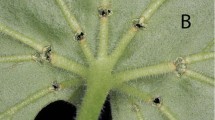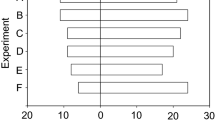Abstract
Many insect folivores sever veins or cut trenches before feeding on leaves that emit fluid from latex, resin, or phloem canals. The behaviors reportedly function to reduce the insect's exposure to exudate. This hypothesis was tested with three species that sever leaf midribs and two species that trench. In each case, the insect's cuts reduced exudation at the distal feeding site by at least 94% relative to an adjacent control leaf. However, most of the insects contacted exudate during the vein-cutting/trenching operation, which could potentially negate any benefits received during feeding. To estimate how much exudate red milkweed beetles (Tetraopes tetrophthalmus) ingest, I weighed beetles before and after vein cutting, and simulated beetle feeding on leaves with and without vein cuts. By severing veins, the beetles decreased their total ingestion of exudate by at least 92%.
Similar content being viewed by others
REFERENCES
Abacus Concepts (1992). StatView, Abacus Concepts, Berkeley.
Ackery, P. R., and Vane-Wright, R. I. (1984). Milkweed Butterflies: Their Cladistics and Biology, Cornell University Press, Ithaca, NY.
Becerra, J. X. (1994). Squirt-gun defense in Bursera and the chrysomelid counterploy. Ecology 75: 1991–1996.
Borkin, S. (1993). Rejection of Apocynum androsaemifolium and A. sibiricum (Apocynaceae) as food plants by larvae of Danaus plexippus: Refutation of early accounts. In Malcolm, S. B., and Zalucki, M. P. (eds.), Biology and Conservation of the Monarch Butterfly, Natural History Museum of Los Angeles County, Los Angeles, pp. 125–128.
Brewer, J. (1977). Short lived phenomena. News Lepid. Soc. 4: 7.
Brower, L. P., Nelson, C. J., Seiber, J. N., Fink, L. S., and Bond, C. (1988). Exaptation as an alternative to coevolution in the cardenolide-based chemical defense of monarch butterflies (Danaus plexippus L.) against avian predators. In Spencer, K. C. (ed.), Chemical Mediation of Coevolution, Academic Press, New York, pp. 447–475.
Buttery, B. R., and Boatman, S. G. (1976). Water deficits and flow of latex. In Kozlowski, T. T. (ed.), Water Deficits and Plant Growth, Vol. IV, Academic Press, New York, pp. 233–289.
Chemsak, J. A. (1963). Taxonomy and bionomics of the genus Tetraopes (Cerambycidae: Coleoptera). Calif. Univ. Publ. Entomol. 30: 1–89.
Compton, S. G. (1987). Aganais speciosa and Danaus chrysippus (Lepidoptera) sabotage the latex defences of their host plants. Ecol. Entomol. 12: 115–118.
Crafts, A. S., and Crisp, C. E. (1971). Phloem Transport in Plants, W. H. Freeman, San Francisco.
d'Auzac, J., Jacob, J., and Chrestin, H. (1989). Physiology of Rubber Tree Latex, CRC Press, Boca Raton, FL.
Dickinson, J. L. (1996). The behavior and ecology of Labidomera Chevrolat (Chrysomelidae: Chrysomelinae). In Jolivet, P. H. A., and Cox, M. L. (eds.), Chrysomelidae Biology, Vol. 2. Ecological Studies, SPB Academic, Amsterdam.
Dillon, P. M., Lowrie, S., and McKey, D. (1983). Disarming the “Evil Woman”: Petiole constriction by a sphingid larva circumvents mechanical defenses of its host plant, Cnidoscolus urens (Euphorbiaceae). Biotropica 15: 112–116.
Duffey, S. S., and Scudder, G. G. E. (1972). Cardiac glycosides in North American Asclepiadaceae, a basis for unpalatability in brightly coloured Hemiptera and Coleoptera. J. Insect Physiol. 18: 63–78.
Dussourd, D. E. (1993). Foraging with finesse: Caterpillar adaptations for circumventing plant defenses. In Stamp, N. E., and Casey, T. (eds.), Caterpillars: Ecological and Evolutionary Constraints on Foraging, Chapman and Hall, New York, pp. 92–131.
Dussourd, D. E. (1995). Entrapment of aphids and whiteflies in lettuce latex. Ann. Entomol. Soc. Am. 88: 163–172.
Dussourd, D. E., and Denno, R. F. (1991). Deactivation of plant defense: Correspondence between insect behavior and secretory canal architecture. Ecology 72: 1383–1396.
Dussourd, D. E., and Denno, R. F. (1994). Host range of generalist caterpillars: Trenching permits feeding on plants with secretory canals. Ecology 75: 69–78.
Dussourd, D. E., and Eisner, T. (1987). Vein-cutting behavior: Insect counterploy to the latex defense of plants. Science 237: 898–901.
Eichlin, T. D., and Cunningham, H. B. (1978). The Plusiinae (Lepidoptera: Noctuidae) of America north of Mexico, emphasizing genitalic and larval morphology. U.S. Dep. Agr. Tech. Bull. 1567: 1–122.
Eickwort, K. R. (1977). Population dynamics of a relatively rare species of milkweed beetle (Labidomera). Ecology 58: 527–538.
Eschrich, W., Evert, R. F., and Heyser, W. (1971). Proteins of the sieve-tube exudate of Cucurbita maxima. Planta 100: 208–221.
Fahn, A. (1979). Secretory Tissues in Plants, Academic Press, New York.
Farrell, B. D., Dussourd, D. E., and Mitter, C. (1991). Escalation of plant defense: Do latex/resin canals spur plant diversification? Am. Nat. 138: 891–900.
Gonzalez, A. G. (1977). Lactuceae—Chemical review. In Heywood, V.H., and Harborne, J. B. (eds.), The Biology and Chemistry of the Compositae, Academic Press, New York, pp. 1081–1095.
Lewinsohn, T. M. (1991). The geographical distribution of plant latex. Chemoecology 2: 64–68.
MacGibbon, D. B., and Mann, J. D. (1986). Inhibition of animal and pathogenic fungal proteases by phloem exudate from pumpkin fruits (Cucurbitaceae). J. Sci. Food Agr. 37: 515–522.
Malcolm, S. B. (1995). Milkweeds, monarch butterflies and the ecological significance of cardenolides. Chemoecology 5/6: 101–117.
McCloud, E. S., Tallamy, D. W., and Halaweish, F. T. (1995). Squash beetle trenching behavior: Avoidance of cucurbitacin induction or mucilaginous plant sap? Ecol. Entomol. 20: 51–59.
Metcalfe, C. R., and Chalk, L. (1983). Anatomy of the Dicotyledons, Vol. II, Clarendon Press, Oxford.
Nelson, C. J., Seiber, J. N., and Brower, L. P. (1981). Seasonal and intraplant variation of cardenolide content in the California milkweed, Asclepias eriocarpa, and implications for plant defense. J. Chem. Ecol. 7: 981–1010.
Raffa, K. F. (1991). Induced defensive reactions in conifer-bark beetle systems. In Tallamy, D. W., and Raupp, M. J. (eds.), Phytochemical Induction by Herbivores, John Wiley and Sons, New York, pp. 245–276.
Read, S. M., and Northcote, D. H. (1983). Chemical and immunological similarities between the phloem proteins of three genera of the Cucurbitaceae. Planta 158: 119–127.
Rees, S. B., and Harborne, J. B. (1985). The role of sesquiterpene lactones and phenolics in the chemical defence of the chicory plant. Phytochemistry 24: 2225–2231.
Seiber, J. N., Nelson, C. J., and Lee, S. M. (1982). Cardenolides in the latex and leaves of seven Asclepias species and Calotropis procera. Phytochemistry 21: 2343–2348.
Sharma, J. R., and Gupta, M. M. (1994). Genetic and chemical analysis for alkaloids in Papaver. In Linskens, H. F., and Jackson, J. F. (eds.), Alkaloids, Springer-Verlag, New York, pp. 215–234.
Stark, R. W. (1965). Recent trends in forest entomology. Annu. Rev. Entomol. 10: 303–324.
Sutherland, D. W. S., and Greene, G. L. (1984). Cultivated and wild host plants. In Lingren, P. D., and Green, G. L. (eds.), Suppression and management of cabbage looper populations. U.S. Dept. Agr. Tech. Bull. 1684: 1–13.
Tallamy, D. W. (1985). Squash beetle feeding behavior: An adaptation against induced cucurbit defenses. Ecology 66: 1574–1579.
Tallamy, D. W. (1986). Behavioral adaptations in insects to plant allelochemicals. In Brattsten, L. B., and Ahmad, S. (eds.), Molecular Aspects of Insect-Plant Associations, Plenum Press, New York, pp. 273–300.
Wilkins, M. B. (ed.) (1984). Advanced Plant Physiology, Pitman, Marshfield, MA.
Zalucki, M. P., and Brower, L. P. (1992). Survival of first instar larvae of Danaus plexippus (Lepidoptera: Danainae) in relation to cardiac glycoside and latex content of Asclepias humistrata (Asclepiadaceae). Chemoecology 3: 81–93.
Author information
Authors and Affiliations
Rights and permissions
About this article
Cite this article
Dussourd, D.E. Behavioral Sabotage of Plant Defense: Do Vein Cuts and Trenches Reduce Insect Exposure to Exudate?. Journal of Insect Behavior 12, 501–515 (1999). https://doi.org/10.1023/A:1020966807633
Issue Date:
DOI: https://doi.org/10.1023/A:1020966807633




